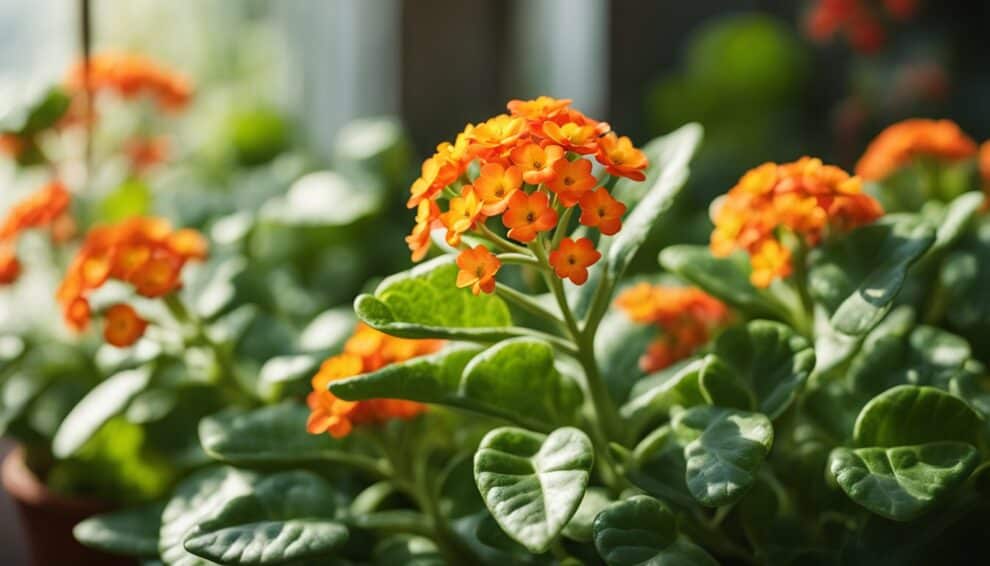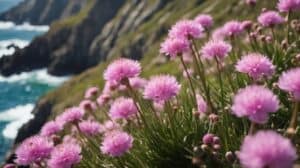Kalanchoe blossfeldiana, commonly known as Flaming Katy, is a popular houseplant that is easy to care for and produces beautiful blooms.
Native to Madagascar, this succulent plant has thick, fleshy leaves and produces clusters of small, vibrant flowers in shades of pink, red, orange, and yellow.
Flaming Katy is a great choice for beginner gardeners and those looking to add a pop of color to their indoor space.

One of the reasons Flaming Katy is so popular is its low maintenance requirements.
This plant thrives in bright, indirect light and only needs to be watered when the soil is dry to the touch.
It can also tolerate a wide range of temperatures, making it a great choice for homes with varying climates.
With proper care, Flaming Katy can bloom for several months, adding a cheerful touch to any room.
In this beginner’s guide to Kalanchoe blossfeldiana, readers will learn everything they need to know to care for this charming plant.
From selecting the right potting soil to pruning and propagating, this article will provide step-by-step instructions and helpful tips to ensure that your Flaming Katy thrives.
Whether you’re a seasoned gardener or a first-time plant parent, Flaming Katy is sure to bring joy and beauty to your home.
Understanding Kalanchoe Blossfeldiana
Species Overview
Kalanchoe Blossfeldiana, commonly known as Flaming Katy, is a popular houseplant that belongs to the Crassulaceae family.
It is native to Madagascar and is widely cultivated as an ornamental plant due to its attractive foliage and long-lasting blooms.
Flaming Katy is a succulent plant that can grow up to 12 inches tall and 6 inches wide. Its leaves are thick, fleshy, and oval-shaped, with a glossy texture.
The plant produces clusters of small, bell-shaped flowers that come in a range of colors, including red, orange, pink, white, and yellow.
Origins and Habitat
Kalanchoe Blossfeldiana is native to Madagascar, an island off the coast of Africa. It grows in rocky, arid regions and is well adapted to dry conditions.
The plant has thick, succulent leaves that store water, allowing it to survive in areas with little rainfall.
In its natural habitat, Flaming Katy blooms in the winter and early spring, producing flowers that attract pollinators such as bees and butterflies.
Overall, Kalanchoe Blossfeldiana is a low-maintenance plant that is easy to care for and adds a pop of color to any indoor space.
With proper care, it can bloom for several weeks, making it a great choice for beginners or anyone looking for a low-maintenance houseplant.
Caring for Your Flaming Katy

Light and Temperature Requirements
Flaming Katy plants thrive in bright, indirect light. They can tolerate some direct sunlight, but too much can scorch their leaves.
Place your plant near a window that faces east or west for optimal light exposure.
In terms of temperature, Flaming Katy plants prefer temperatures between 60-85°F (15-29°C).
They can tolerate slightly cooler temperatures, but avoid exposing them to temperatures below 50°F (10°C).
Watering and Feeding
Flaming Katy plants prefer to be kept on the drier side, so be careful not to overwater them. Allow the top inch of soil to dry out before watering.
When you do water, make sure to thoroughly saturate the soil and allow any excess water to drain out.
Feeding your Flaming Katy plant is important for maintaining its health and promoting blooming.
Use a balanced fertilizer once a month during the growing season (spring and summer).
Be sure to follow the instructions on the fertilizer packaging for proper application.
Pruning and Maintenance
Flaming Katy plants benefit from regular pruning to promote bushier growth and more blooms.
Prune back any leggy or overgrown stems to just above a leaf node. This will encourage new growth and help maintain the plant’s shape.
In terms of general maintenance, Flaming Katy plants are relatively low-maintenance.
Keep an eye out for any signs of pests or diseases, and address them promptly if they arise.
Dust the leaves occasionally to keep them clean and free of debris.
By following these simple care tips, you can enjoy a beautiful and healthy Flaming Katy plant in your home or garden.
Propagation Techniques

Leaf Cuttings
One of the easiest ways to propagate Flaming Katy is through leaf cuttings.
This method involves removing a leaf from the plant and allowing it to develop roots and a new plant.
To do this, select a healthy leaf from the parent plant and gently twist it off. Make sure to choose a leaf that is not damaged or diseased.
Next, let the leaf dry for a day or two to allow the wound to callous over.
Once the wound has healed, dip the end of the leaf in rooting hormone and plant it in a well-draining soil mix.
Water the soil lightly and place the cutting in a warm, bright location.
After a few weeks, the leaf should start to develop roots and a small plantlet.
At this point, you can transplant the new plant into its own pot and care for it as you would a mature Flaming Katy plant.
Offsets
Another method of propagating Flaming Katy is through offsets. Offsets are small plantlets that grow from the base of the parent plant.
To propagate through offsets, wait until the plant has produced several small plantlets.
Gently remove the offsets from the parent plant and plant them in their own pots with well-draining soil.
Water the soil lightly and place the new plants in a warm, bright location.
As the new plants grow, make sure to water them regularly and provide them with plenty of light.
With proper care, the new plants will grow into mature Flaming Katy plants and produce their own offsets, continuing the propagation cycle.
Troubleshooting Common Issues

Pest Infestations
Pests can be a major problem for Flaming Katy plants, especially if they are kept indoors.
Here are some common pests to watch out for and how to deal with them:
-
Mealybugs: These small, white insects can be found on the leaves and stems of the plant.
They suck on the sap of the plant and can cause it to weaken and die.
To get rid of mealybugs, wipe the leaves and stems with a cotton swab dipped in rubbing alcohol. You can also use an insecticidal soap to kill them.
-
Spider Mites: These tiny, red or brown insects can be found on the undersides of the leaves.
They suck on the sap of the plant and can cause it to turn yellow and dry out.
To get rid of spider mites, spray the plant with a strong jet of water or use an insecticidal soap.
-
Scale Insects: These small, brown insects can be found on the leaves and stems of the plant.
They suck on the sap of the plant and can cause it to weaken and die.
To get rid of scale insects, wipe the leaves and stems with a cotton swab dipped in rubbing alcohol. You can also use an insecticidal soap to kill them.
Diseases and Disorders
Flaming Katy plants can also be susceptible to a variety of diseases and disorders. Here are some common ones to watch out for:
-
Root Rot: This is a fungal disease that can be caused by overwatering or poor drainage.
The roots of the plant will start to rot and turn brown.
To prevent root rot, make sure the soil is well-draining and only water the plant when the top inch of soil is dry.
-
Leaf Spot: This is a fungal disease that can be caused by overwatering or high humidity.
The leaves of the plant will develop brown or black spots.
To prevent leaf spot, make sure the plant has good air circulation and avoid getting water on the leaves.
-
Yellowing Leaves: This can be caused by a variety of factors, including overwatering, underwatering, poor soil quality, or lack of nutrients.
To fix yellowing leaves, make sure the plant is getting the right amount of water and nutrients and that the soil is well-draining.
Frequently Asked Questions

How do I encourage my Flaming Katy to bloom?
To encourage your Flaming Katy to bloom, make sure it receives plenty of bright, indirect sunlight and is kept in a warm environment.
Keep the soil moist, but not waterlogged, and avoid over-fertilizing.
You can also try placing your plant in a cooler room or reducing the amount of light it receives for a short period of time to encourage blooming.
What are the best practices for pruning a Flaming Katy?
Pruning your Flaming Katy can help promote bushier growth and prevent it from becoming too leggy.
Use a clean pair of scissors or pruning shears to snip off any dead or damaged leaves or stems.
You can also prune back the tips of the stems to encourage branching. Just be sure not to remove too much foliage, as this can stress the plant.
Why is my Flaming Katy growing tall and leggy?
If your Flaming Katy is growing tall and leggy, it may be due to insufficient light or over-fertilization.
Move your plant to a brighter location and reduce the amount of fertilizer you’re using.
You can also pinch back the tips of the stems to encourage branching and promote a bushier growth habit.
What common problems should I look out for with a Flaming Katy?
Flaming Katy plants are generally easy to care for, but they can be susceptible to a few common problems.
Watch out for signs of overwatering, such as yellowing leaves or a mushy stem.
Mealybugs and spider mites can also be a problem, so inspect your plant regularly for signs of infestation.
Can you explain the steps for propagating a Flaming Katy plant?
To propagate a Flaming Katy, take a stem cutting that is at least 2-3 inches long and remove the lower leaves.
Dip the cut end in rooting hormone and plant it in a small pot filled with moist potting soil. Keep the soil moist and place the pot in a warm, bright location.
After a few weeks, your cutting should begin to develop roots and new growth.
What are the ideal indoor care tips for a Flaming Katy?
Flaming Katy plants prefer bright, indirect sunlight and a warm, humid environment. Keep the soil moist, but not waterlogged, and avoid over-fertilizing.
You can also mist your plant regularly to help increase humidity.
If you notice your plant becoming leggy, move it to a brighter location or consider using a grow light to supplement its light needs.














